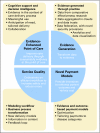Rapid-learning system for cancer care
- PMID: 20585094
- PMCID: PMC2953977
- DOI: 10.1200/JCO.2010.28.5478
Rapid-learning system for cancer care
Abstract
Compelling public interest is propelling national efforts to advance the evidence base for cancer treatment and control measures and to transform the way in which evidence is aggregated and applied. Substantial investments in health information technology, comparative effectiveness research, health care quality and value, and personalized medicine support these efforts and have resulted in considerable progress to date. An emerging initiative, and one that integrates these converging approaches to improving health care, is "rapid-learning health care." In this framework, routinely collected real-time clinical data drive the process of scientific discovery, which becomes a natural outgrowth of patient care. To better understand the state of the rapid-learning health care model and its potential implications for oncology, the National Cancer Policy Forum of the Institute of Medicine held a workshop entitled "A Foundation for Evidence-Driven Practice: A Rapid-Learning System for Cancer Care" in October 2009. Participants examined the elements of a rapid-learning system for cancer, including registries and databases, emerging information technology, patient-centered and -driven clinical decision support, patient engagement, culture change, clinical practice guidelines, point-of-care needs in clinical oncology, and federal policy issues and implications. This Special Article reviews the activities of the workshop and sets the stage to move from vision to action.
Conflict of interest statement
Authors' disclosures of potential conflicts of interest and author contributions are found at the end of this article.
Figures



References
-
- Skinner J, Staiger D, Fisher ES. Looking back, moving forward. N Engl J Med. 2010;362:569–574. - PubMed
-
- Orszag PR, Ellis P. The challenge of rising health care costs: A view from the Congressional Budget Office. N Engl J Med. 2007;357:1793–1795. - PubMed
-
- Eden J, Wheatley B, McNeil B, et al. Washington, DC: National Academies Press; 2008. Knowing What Works in Health Care: A Roadmap for the Nation.
Publication types
MeSH terms
LinkOut - more resources
Full Text Sources
Other Literature Sources

